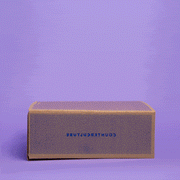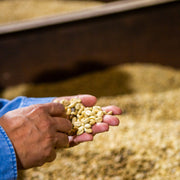Lovers of decaffeinated coffee drink coffee because, more than anything, they love the flavor. We feel a particular responsibility to the decaf drinker and have made it our mission to roast the best decafs on the planet.
Coffee beans are naturally caffeinated. That invigorating quality is a large part of why coffee has been consumed for centuries. We have written all about the specifics of caffeine in coffee, so how is decaf coffee decaffeinated? Let's take a look at caffeine and the different decaffeination processes.

How Much Caffeine Is In A Cup Of Coffee?
First up, let's talk about caffeine levels. The average 8-ounce cup of coffee has about 95 milligrams of caffeine. Counter Culture hasn’t tested the amount of caffeine in its coffee, but there are some universal variables that influence the amount of caffeine in a cup of coffee. One of the most significant factors is the species and variety of the beans. Different species and varieties of coffee start with different amounts of caffeine. The species robusta, for instance, has roughly double the amount of caffeine as arabica. Counter Culture doesn’t buy robusta, but we purchase many varieties of arabica, which all have varying amounts of caffeine in them.
Unfortunately, decaffeinated coffees have been relegated to secondary status by most of the world’s coffee roasters, who use low-quality coffees and cheap processes to create their decafs. We have always resisted this impulse, buying instead the highest-quality coffees and decaffeinating them to order two different processes.
What Is Decaf Coffee?
While caffeine levels fluctuate, it is possible to remove the naturally occurring caffeine from the beans almost entirely. As you guessed, this process is called decaffeination and it happens before the coffee is roasted. Counter Culture uses two different methods to decaffeinate our coffees: organic chemical solvents like ethyl acetate, or via the water method. All methods remove at least 97 percent of the caffeine that was originally in the coffee.

Ethyl Acetate Decaffeination Process
All of the single-origin decaf coffees we offer come from Colombia. These coffees are decaffeinated by the ethyl acetate process, also known as EA, in Colombia before they are shipped to us. Along with coffee, sugarcane is a huge industry in Colombia. EA is a natural, organic chemical derived from the processing of sugarcane. Using it as a way to decaffeinate coffee is a win-win solution that also accentuates the coffee's natural sweetness.
In the EA process, coffee is warmed to open the beans' pores. It's then sprayed with ethyl acetate, which binds to the caffeine molecules inside the bean. After another slight warming and rinse, the coffee is left sitting while the EA evaporates, taking the caffeine with it. This process is repeated until caffeine levels have been sufficiently lowered. After the decaffeination process is finished, there is a minute amount of EA left in the coffee, many hundreds of times less than in a banana. It's completely safe!
Water Decaffeination Process
Probably the most famous brand-name in decaffeination is the Swiss Water Process. Despite the name, our coffee is not shipped to Switzerland for decaffeination. Swiss Water decaffeinates coffee in British Columbia, Canada before shipping the decaf coffee to our roasteries. We use Swiss Water to decaffeinate our year-round decaf coffee, Slow Motion. This water-only process uses pure water and proprietary carbon filters to remove caffeine. We prefer this process because it results in coffee that is 99.9 percent caffeine-free, certified organic, and accentuate the body of the coffee.
In the Swiss Water Process, green coffee beans are washed and hydrated in purified water. Caffeine and flavor compounds migrate out of the coffee into the water. The caffeine is removed from the water using carbon filters, and what is left is a solution of green coffee extract (GCE). Another batch of coffee is mixed into the GCE, and the caffeine migrates out into the GCE, but all of the flavor is left because the GCE is already full. Caffeine is once again trapped in carbon filters and separated from the GCE, and then the process repeats itself. And — voila — you have decaffeinated coffee!
Since fresh coffee always tastes better—and freshness is even more important in decaffeinated coffee—we always decaffeinate in small, frequent batches throughout the year to maintain the highest quality imaginable. All this effort, along with our commitment to high quality and natural processes, means that our decafs are a little more expensive, but they’re worth it.
We strive to make our decaf coffees are just as enjoyable as caffeinated coffee. Especially because decaf drinkers, more than anyone, are drinking coffee for its flavor. Try one of our decaf coffees, and we know you’ll love it. After all, decaf is for coffee lovers!






